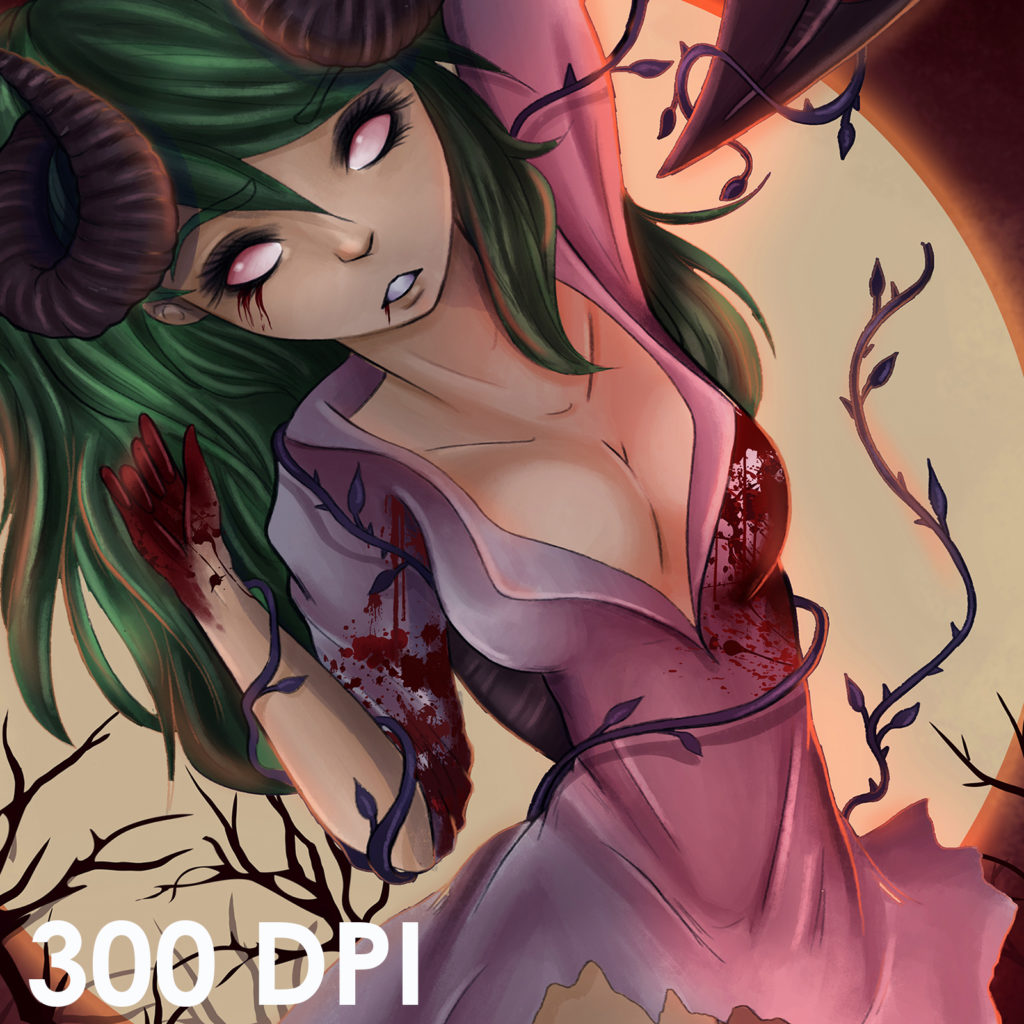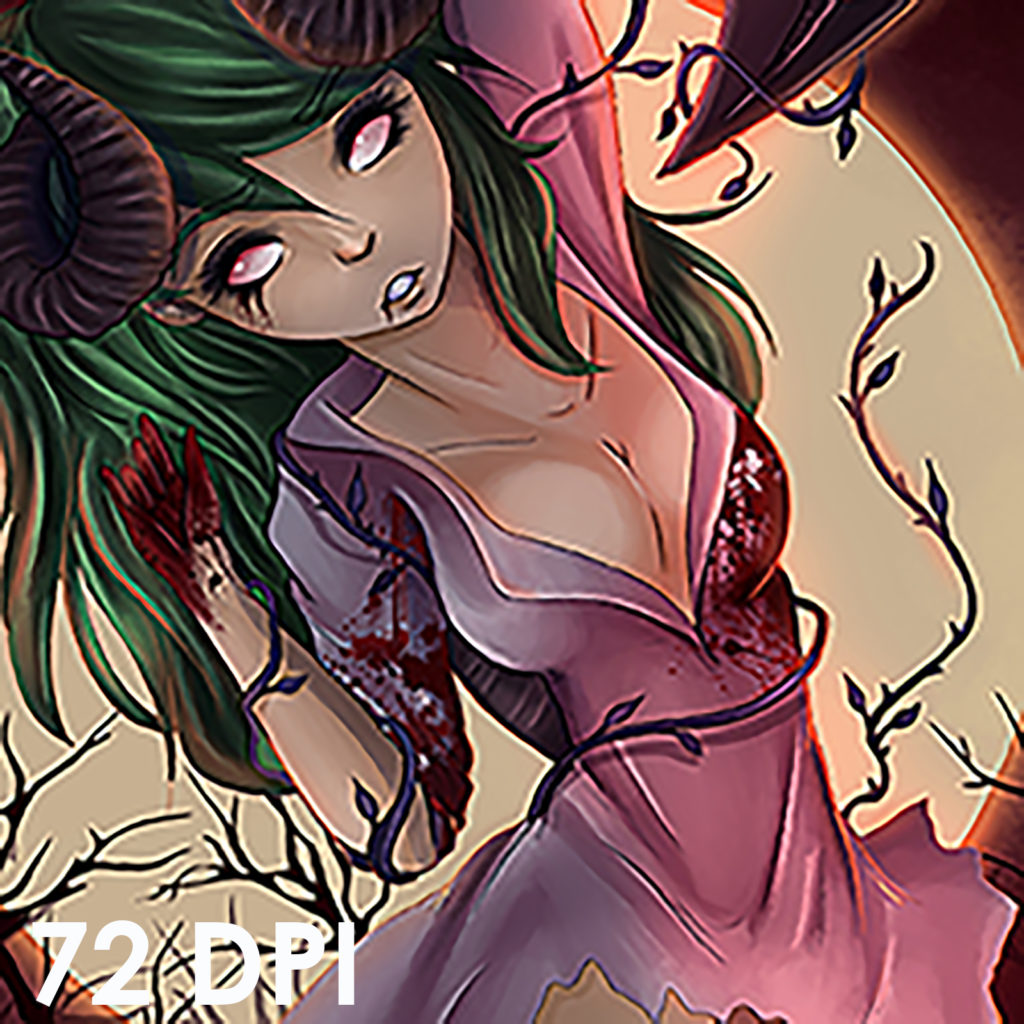
Color
For best color results, please send us your artwork in CMYK color space. We can still accept RGB files, however there is no guarantee on how the colors will turn out in print. Usually RGB prints a bit darker than what is seen on screen.

CMYK color space provides the most accurate color matching to your original artwork, and is recommended for printing.

RGB color space provides richer colors, but they don’t always translate in print. RGB is best for digital artwork meant to be viewed on a screen.
Resolution
For best results, and to avoid any pixelation of your artwork in print, please send us files at a minimum 300DPI. Anything under that could result in diminished print quality.

Image Printed at 300 DPI; Optimal Print Quality

Image Printed at 150 DPI; Artwork is blurry and not as crisp.

Image Printed at 72DPI; Noticeable artwork degradation.
File Format
For posters, cards, or any flat printable items, please send them as either JPG, PNG, TIFF, or PDF. Note: PNG files only print in RGB color space.
For books, PDFs are STRONGLY preferred. Please send books in the following way:
- Covers – Please send one PDF containing the Cover (First PDF page), Inside Front Cover (Second PDF page), Inside Back Cover (Third PDF page) and Back Cover (Fourth PDF page). Note: If you have variant covers for your book, send EACH cover with these 4 pages in it.
- Interiors – Please send one PDF containing all Interior pages (pages, not spreads) in their intended order.
If you prefer to send them as JPGs, PNGs or TIFFs, be sure to explicitly name each file so there is no confusion. Example:
- Cover – Cover.jpg
- Back Cover – Back Cover.jpg
- Inside Front Cover – Inside Front Cover.jpg
- Inside Back Cover – Inside Back Cover.jpg
- Interior Pages – Page 1.jpg; Page 2.jpg; Page 3.jpg etc.
For Stitched books, page counts MUST be a multiple of 4. Each sheet they are printed on contains 4 pages of the book, and having an odd number of pages will leave undesired blank white pages in your book.
Stock Types
Depending on what you want to produce, it is important to select the right stock! For best results, some stocks may require special artwork setup, such as the metallic and holofoil stocks.
Be sure to pick the best stock for your order to get the best in printing and satisfaction.
100# Text Stock
- Most commonly used stock for comic book covers
70# Gloss Text Stock
- Most commonly used stock for comic book interiors with a glossy finish
60# Matte Text Stock
- Used for comic book interiors for those who prefer something as close to newsprint as they can get via digital printing.
100# Matte Card Stock
- Best for lineart, watercolor or hand drawn artwork.
100# Gloss Card Stock
- Best for digital art, digitally colored art or photography.
- Upgrade for comic book covers for a more premium feel.
- For prints, rolls easier for shipping versus the 111# Gloss Card Stock.
111# Gloss Card Stock
- Most commonly used stock for prints.
- Best for digital art, digitally colored art or photography.
- Heavier weight gloss stock allows for better presentation at conventions and shows.
Gold, Silver or Pearl Metallic Card Stock
- Vibrant stock that accentuates artwork with a metallic finish.
- Artwork will pop off the sheet depending on color bias. If your artwork features more gold, use the gold metallic stock. If it features more silver, use the silver metallic stock. The pearl metallic stock is a neutral finish that accentuates all colors, and gives the image a nice sheen.
- Popular stock used for premium comic book variant covers.
- White areas of the artwork or whiter areas will show more of the paper finish, so setup your artwork accordingly.
Holofoil Card Stock
- Vibrant stock that accentuates the artwork with a reflective rainbow foil finish.
- Very popular stock used for premium comic book variant covers.
- White areas of the artwork or whiter areas will show more of the paper finish, so setup your artwork accordingly.
Spot Foil
ArtistExpress needs a PSD with a layer for the BASE ART of your artwork and another layer for the FOIL area to be foiled in solid black, with transparency. You must also knock out the foil area on the BASE ART layer in white. It is STRONGLY recommended that the foil layer has a 1px stroke also in solid black. The foil area can’t have any glow or soft edge effects.

Make sure your layers look like this, and that there is a 1px stroke on the FOIL layer!

An example of the FOIL layer, with the 1px stroke.

An example of the BASE ART layer, with the foil area knocked out in white. If there is color in this area, it will be overprinted on the foil.
